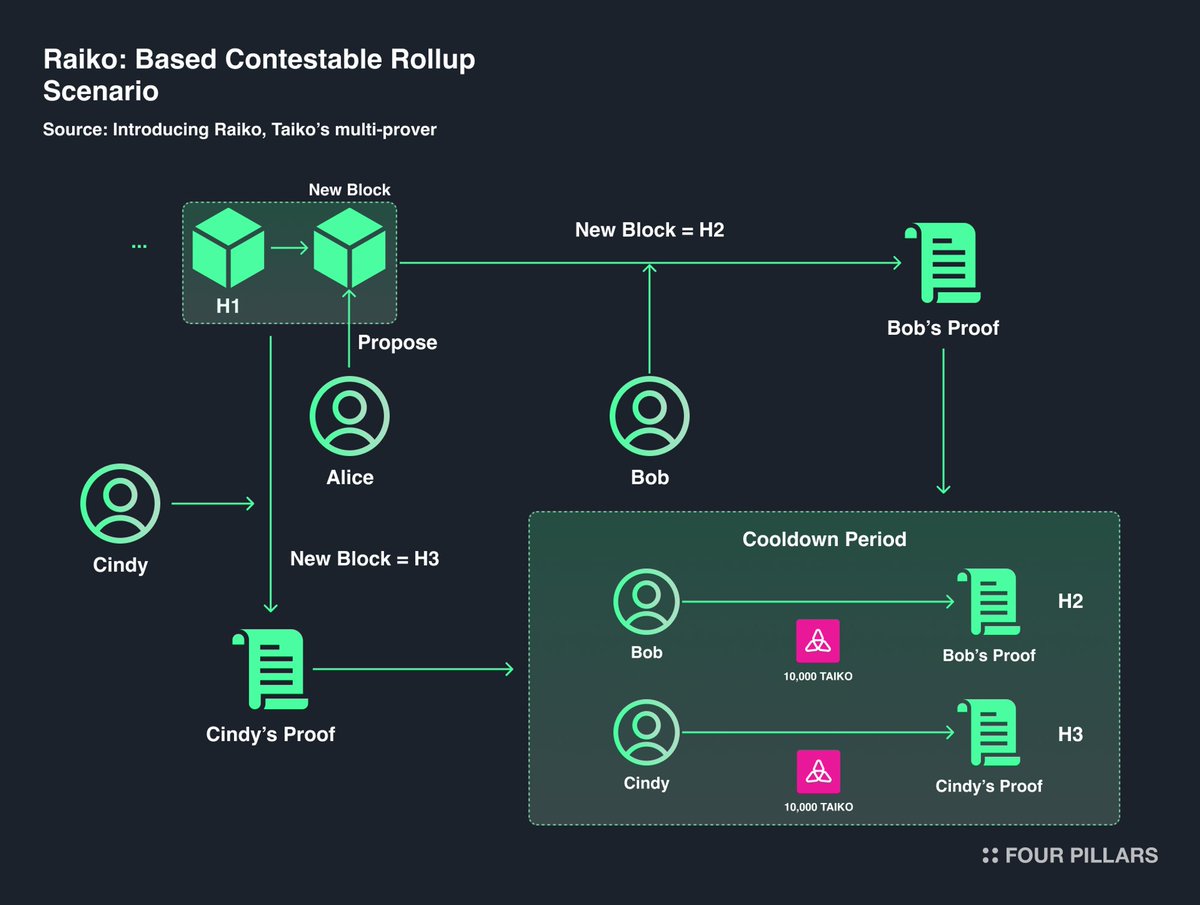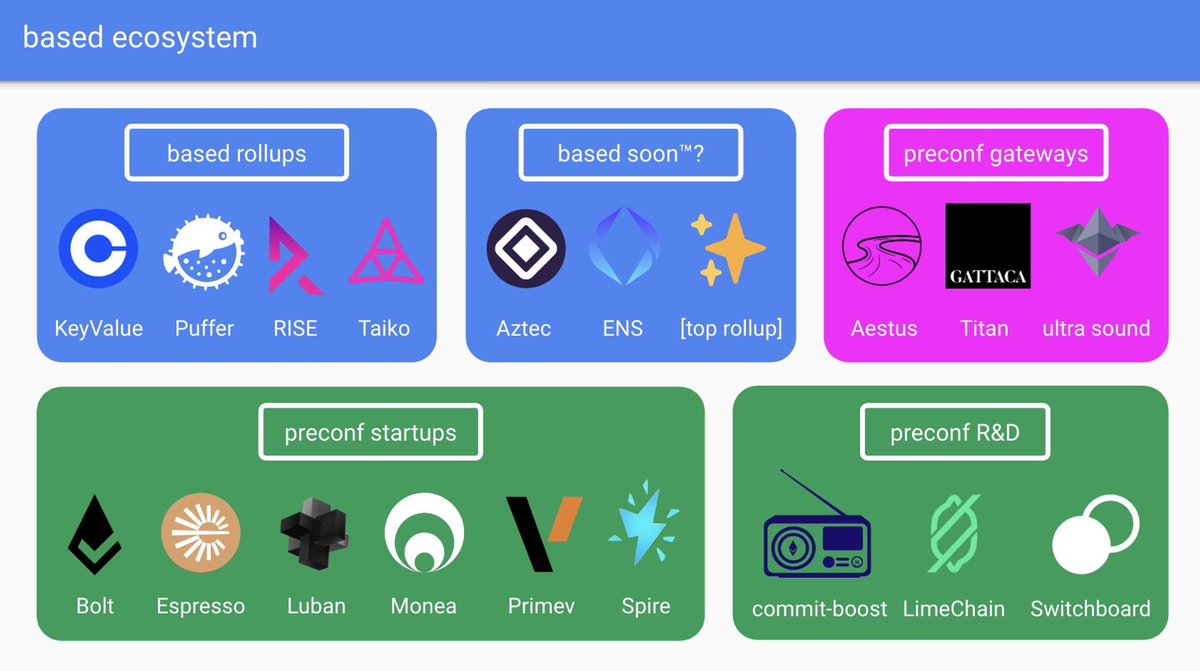Decentralization is a core value of blockchain. However, to enhance Ethereum's scalability, some decentralization was sacrificed in the rollup operations. Fully decentralizing these operations still faces challenges in sequencing and proof settlement for both optimistic and zk based Rollups.
Despite these challenges, development is accelerating. Some optimistic rollups have introduced permissionless challenges and are testing hybrid proof systems. Taiko stands out as a project with a clear roadmap for decentralization. Let's explore why.
Taiko's "Path to Decentralized Rollup" introduces two approaches for the proof system and the framework: Based Contestable Rollup (BCR) and Based Booster Rollup (BBR). Let’s look into this.
BCR is a rollup design that incorporates a contestation mechanism. This design allows for the verification of transactions by enabling participants to challenge the validity of transactions if there is suspicion of fraud. It enhances decentralization by allowing Ethereum validators to sequence transactions without a central sequencer, using a contestation mechanism to maintain blockchain integrity.
The BCR mechanism combines the strengths of Ethereum's transaction sequencing with this contestation feature, aiming to reduce transaction fees while maintaining security and decentralization.
Moreover, Taiko has adopted a multi-proof system within the BCR. This system allows the use of different rollup proof systems (SGX, ZK, SGX+ZK, etc.) depending on the stage, ensuring system flexibility and more stable operations.
Despite these advantages, this design could have a drawback: the lack of prover activity when competition frequency is low. The structure for prover requires a large amount of competition to generate profits, so in environments where this is not the case, it may be a better choice for them not to participate. To prevent this issue, Taiko has implemented a dynamic adjustment to different rollup proof systems, allowing the problem to be addressed.

BBR is designed to scale Ethereum dapps without requiring redeployment on all L2 solutions. It achieves this by sharding transaction execution and storage, which minimizes developer efforts and reduces redeployment costs. This design aims to address liquidity fragmentation across L2s and enhances network scalability.
In November 2023, Taiko launched Gwyneth, a booster rollup initiative to enhance Ethereum's capabilities. Gwyneth uses Ethereum's L1 validators for transaction sequencing and L1 builders for block construction. Its key features include synchronous composability for seamless L1 integration, scalability to meet growing demand, and preconfirmation capability for fast transactions.
Gwyneth is "born finalized," secured by Taiko's multi-prover system, Raiko, and uses Trusted Execution Environments (TEE) with plans to incorporate zkVMs in the future.

Both BCR and BBR are part of Taiko's efforts to provide efficient scaling solutions for Ethereum, ensuring high transaction volumes can be handled while maintaining security and decentralization.
Rollups are currently mostly centralized. Decentralizing sequencing and proof systems is still in progress. Two well-known proof systems, optimistic and zk rollups, are advancing towards decentralization.
Optimistic proof systems: These have implemented forced L1 transactions and are exploring shared sequencing and incorporating permissionless challengers. Arbitrum and Optimism allowed permissionless challenges, but Optimism recently disallowed them due to a suspicious bug.
ZK proof systems: Most zkRollups don't allow forced transactions in L1. While zk provides secure state change guarantees, operations are currently centralized. Significant technical challenges remain.
Although not perfectly decentralized, rollup frameworks like OP-Stack, ZK-Stack, Polygon zkEVM, and Arbitrum Orbit are now used by hundreds of L2s. This trend is continuing, and rollup framework teams are working on to make it decentralized. However, not all projects have clear roadmaps to address decentralization challenges.
Taiko stands out in this regard. From its inception, it has had a clear roadmap to become both an L2 and a decentralized rollup framework. It has a clear path forward with working tokenomics that provide sustainable utility for its L2 token—a feature most others lack.
Will Taiko successfully deliver its vision with the right market timing? As other projects are also improving their codebase and infrastructure, only time will tell. As Taiko has been one of the team working closely with Ethereum Foundation, It's crucial to monitor Taiko's progress towards its development especially on its decentralization.
Currently, major rollup projects are making strenuous efforts to achieve the decentralization of rollups. However, none have made significant progress in realizing complete decentralization. The primary reason is that most of the dominant rollups today placed a low priority on decentralization during their initial design phases. These rollups, which were primarily focused on performance and functionality from the outset, now find it extremely difficult to incorporate the concept of decentralization into their tightly constrained designs. This is understandable because, in the early days, rollups needed to deliver visible results with high-speed performance while meeting Ethereum's scalability needs.
However, the concept of decentralization in rollups is becoming increasingly important now. It's akin to how the centralized, performance-driven Web2 era naturally transitioned into the decentralized Web3 era. Thankfully, many rollup projects have already laid the groundwork and established a foundation, paving the way forward. In this context, Taiko's attempt at decentralizing rollups is worth noting positively. Especially with its Based Contestable Rollup (BCR) at the forefront, Taiko's rollup mechanism is designed with essential elements for complete decentralization, including the ability for anyone to participate, and the presence of fair rewards and penalties.
Of course, there are still many areas that need improvement, and the path to complete decentralization is fraught with challenges. However, Taiko's efforts are considered highly significant and are likely to have a positive impact on the overall Ethereum L2 ecosystem. Their progress is definitely worth keeping an eye on.
Junger has asserted as rollups gain popularity, fragmentation and isolation become key concerns. The choice between based rollups and shared sequencer layers presents a trade-off. Shared sequencers offer fast finality and cross-chain composability but introduce new trust assumptions and potential failure points. Based rollups leverage Ethereum's infrastructure, providing liquidity and L1 composability, but face block time and revenue challenges.
Future improvements may include based preconfirmations and faster L1 block times to enhance user experience while maintaining Ethereum alignment. The goal is a scalable, decentralized ecosystem true to Ethereum's vision.
Junger has emphasized the choice to be based or not is more than a technical decision. It is about the direction of decentralized rollup “framework”.
Justin Drake, a researcher at the Ethereum Foundation, has been actively involved in discussions about Ethereum's scaling solutions, particularly focusing on based rollups and the Taiko project. Drake has emphasized the importance of decentralized sequencing, which can mitigate issues like monopolistic control over transaction sequencing and censorship. He believes that the integration of technologies like zero-knowledge proofs and shared sequencers can enhance the functionality and security of based rollups.
Justin Drake views Taiko as a significant step towards achieving a decentralized and scalable Ethereum ecosystem, with its permissionless sequencing and proving for its mainnet. Also he has expressed that the endgame is “based.”

Source: X (@drakefjustin)
Related Articles, News, Tweets etc. :
Dive into 'Narratives' that will be important in the next year